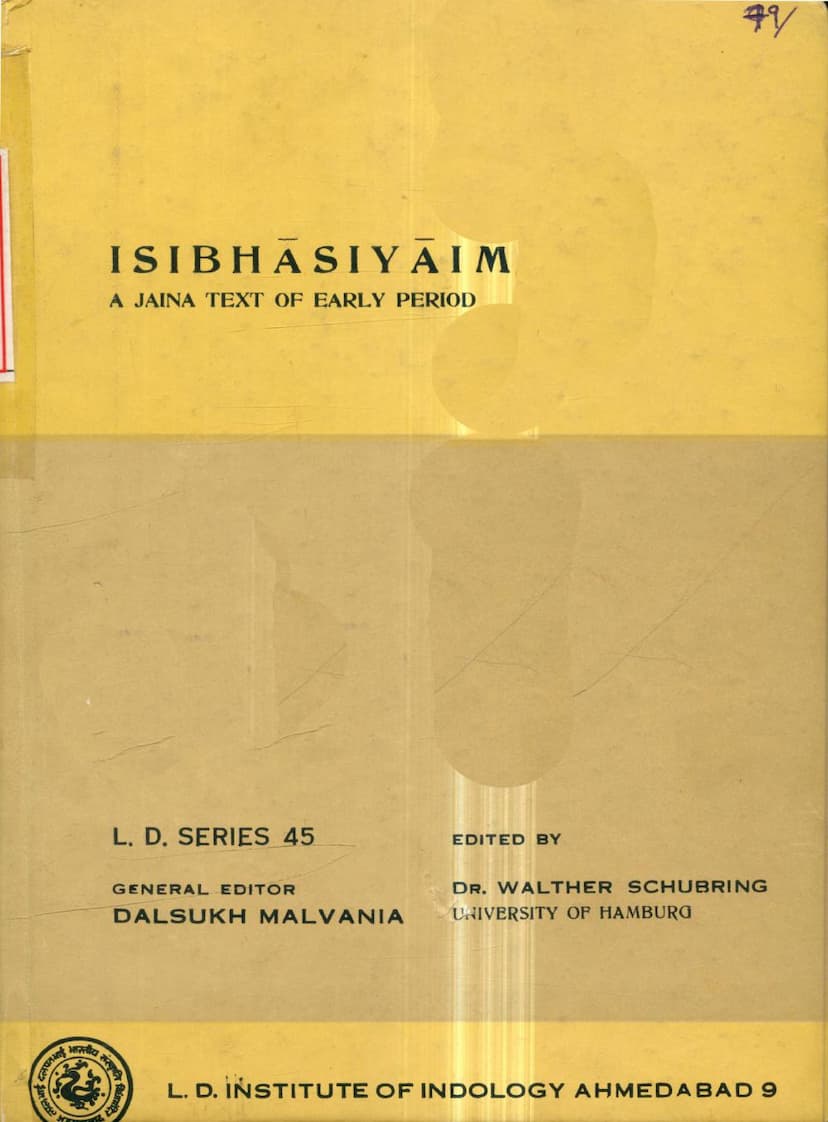Isibhasiyaim
Added to library: September 1, 2025

Summary
Here's a comprehensive summary of the Jain text "Isibhasiyaim," based on the provided text snippets:
Title: Isibhasiyaim (ऋषिभाषितम् - Sayings of the Rishis)
Authors: Walther Schubring (Editor), Dalsukh Malvania (General Editor)
Publisher: L. D. Institute of Indology, Ahmedabad
Period: Early Jain canonical text.
Unique Nature: The "Isibhasiyaim" is a unique Jain canonical work because it compiles the sayings of non-Jaina Rishis. This highlights the catholicity and nobility of early Jain thinkers who collected these sayings to form a canonical text. It also points to the existence of a common ethical thought in early religions of various denominations.
Content and Structure:
- The work consists of 45 chapters (adhyayana), each presenting the dictum (būitam - a mere dictum) of a Rishi, followed by an exposition and conclusion.
- Each section is generally based on the principle of a more or less laconic dictum attributed to a Rishi, which is then discussed more or less minutely and concluded with the stereotype phrase "ti bemi" (thus I say).
- The exposition and motto can contain both prose and verses, or only one of the two. The exposition is often more diffuse than the motto.
- The text includes a substantial amount of metrical material, with ślokas forming the overwhelming majority of the 452 complete stanzas, along with some Vaitālikya, Aupacchandasaka, epic Tristubhs, and Āryās.
- Some chapters exhibit irregularities in the proportion of motto to exposition, and in a few cases, the Rishi's name is implicitly understood or missing (e.g., Chapter 20).
- The work contains sayings attributed to figures who are also known from Buddhist and Brahmanical traditions (e.g., Mahākāśyapa, Vāgalaçiri, Yaugandharāyaṇa, Śariputra). It also includes figures central to Jain tradition like Vardhamana Mahavira, Pārsva, and Gośāla Maskariputra, who are presented as Pratyekabuddhas.
Historical Significance and Context:
- The "Isibhasiyaim" is considered an early Jain text, linked in language and style to senior canonical texts like the Āyāra, Sūyagaḍa, Uttarajjhāyā, and Dasaveyāliya. It is likened to an apocryphal fifth Gospel alongside the four Gospels.
- The term "rși" in this text takes on a special meaning, referring to pratyekabuddhas – individuals who attained the highest knowledge by themselves and did not form a community or school. This concept was useful for propaganda, allowing Jainism to claim figures who might have originally stood aloof from it.
- The text demonstrates the integration of names of Vedic-Brahmanic character and Buddhist figures into the Jain canon, often with disfigured names.
- There was historical uncertainty regarding the exact nature and content of the "Isibhāsiyaim," with mentions in different canonical lists and varying attributions by later commentators like Haribhadra.
- The discovery and publication of an unpretentious pamphlet in 1927 containing the text helped solidify its identity as the ancient "Isibhāsiyaim."
Themes and Ideas:
- Catholicity and Inclusivity: The collection of sayings from non-Jain Rishis demonstrates the early Jain tradition's openness to and acceptance of diverse ethical thought.
- Ethical Principles: The text contains ethical teachings, often presented as concise maxims attributed to Rishis.
- Karman and Liberation: Many verses delve into the concept of Karman, its workings, its consequences, and the path to liberation from it through self-control, penance, and right knowledge.
- Spiritual Discipline: The importance of controlling desires, senses, anger, pride, deceit, and greed is emphasized.
- The Nature of Reality: Some chapters touch upon cosmological theories and the nature of existence, contrasting Brahmanical and Buddhist views with Jain philosophical tenets.
- Ignorance vs. Knowledge: The text highlights the perils of ignorance (ajñāna) and the transformative power of knowledge (jñāna) in overcoming suffering and achieving liberation.
- The Nature of the World: It explores the impermanence of worldly possessions, pleasures, and life itself, contrasting them with the eternal nature of salvation.
Editorial and Scholarly Contribution:
- The edition by Dr. Walther Schubring, originally published in German in 1942 and later with a Sanskrit commentary in 1951, is foundational.
- The L. D. Institute of Indology's publication is a reprint of Schubring's work with an English translation of his German introduction and critical notes.
- The volume includes the text in both Roman and Devanagari scripts, with transliteration by Dr. Nagin J. Shah.
- The edition acknowledges the challenges in reconstructing the text due to textual variations and omissions in manuscripts and earlier printings, necessitating editorial conjectures.
In essence, the "Isibhasiyaim" is a valuable text that offers insight into the syncretic and inclusive nature of early Jainism, its ethical teachings, and its philosophical engagement with other contemporary religious and intellectual traditions. It showcases the sophisticated literary and metrical practices of ancient Jain literature.